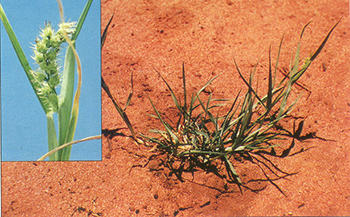Pest plant - Innocent weed
- Fact sheet
- August 2015

Innocent weed (Cenchrus longspinus and Cenchrus incertus) is an annual grass that produces small barbed burrs. It can have a significant negative impact on stock and agricultural produce.
Description
- erect or prostrate annual grass to 60cm high
- several nodular stems branching from the base of the plant
- leaves 20cm x 5-8mm, smooth surface with serrated edges, often with a slight twist
- fruit are straw-coloured burrs in clusters of 3-7mm, with barbed spines 7mm long
- fibrous root system is generally shallow although can be over 30cm deep in some soil types.
Why is it a problem?
- affects crop or pasture systems, grazing land, irrigated crops, horticulture, recreational and amenity areas, roadsides and cultivated land
- can severely reduce the value of wool, hides and crops through contamination
- increases the cost of shearing and slaughter, and can hamper use of working dogs
- burrs can become stuck in the mouths of grazing stock and cause ulcers.
Distribution
- Widespread in the Murray Mallee and isolated patches in irrigated areas along the River Murray
- Eyre Peninsula
- Northern pastoral and agricultural districts
- South East – isolated patches.
Ecology
- establishes in low fertility dry sandy soils and other disturbed areas
- seeds can remain viable for up to three years
- seed is known to germinate from a depth of 25cm beneath the soil surface.
How it spreads
- seeds are easily dispersed by machinery, clothing, wool and fur.